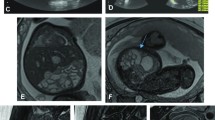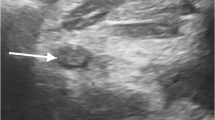Abstract
Background
Prenatal US detection of cloacal malformations is challenging and rarely confirms this diagnosis.
Objective
To define the prenatal MRI findings in cloacal malformations.
Materials and methods
We performed a retrospective study of patients with cloacal malformations who had pre- and post-natal assessment at our institution. Fetal MRI was obtained in six singleton pregnancies between 26 and 32 weeks of gestation. Imaging analysis was focused on the distal bowel, the urinary system and the genital tract and compared with postnatal clinical, radiological and surgical diagnoses.
Results
The distal bowel was dilated and did not extend below the bladder in five fetuses. They had a long common cloacal channel (3.5–6 cm) and a rectum located over the bladder base. Only one fetus with a posterior cloacal variant had a normal rectum. Three fetuses had increased T2 signal in the bowel and two increased T1/decreased T2 signal bladder content. All had renal anomalies, four had abnormal bladders and two had hydrocolpos.
Conclusion
Assessment of the anorectal signal and pelvic anatomy during the third trimester helps to detect cloacal malformations in the fetus. The specificity for this diagnosis was highly increased when bowel fluid or bladder meconium content was identified.









Similar content being viewed by others
References
Hendren WH (1996) Urogenital sinus and cloacal malformations. Semin Pediatr Surg 5:72–79
Jaramillo D, Lebowitz RL, Hendren WH (1990) The cloacal malformation: radiologic findings and imaging recommendations. Radiology 177:441–448
Veyrac C, Couture A, Saguintaah M et al (2004) MRI of fetal GI tract abnormalities. Abdom Imaging 29:411–420
Morikawa M, Yamada T, Cho K et al (2006) Prenatal diagnosis and therapy of persistent cloaca: a case report. Fetal Diagn Ther 21:343–347
Peña A (1995) Anorectal malformations. Semin Pediatr Surg 4:35–47
Peña A, Levitt MA, Hong A et al (2004) Surgical management of cloacal malformations: a review of 339 patients. J Pediatr Surg 39:470–479, discussion 470–479
Petrikovsky BM, Walzak MP Jr, D’Addario PF (1988) Fetal cloacal anomalies: prenatal sonographic findings and differential diagnosis. Obstet Gynecol 72:464–469
Warne S, Chitty LS, Wilcox DT (2002) Prenatal diagnosis of cloacal anomalies. BJU Int 89:78–81
Saguintaah M, Couture A, Veyrac C et al (2002) MRI of the fetal gastrointestinal tract. Pediatr Radiol 32:395–404
Couture A (2008) Fetal gastrointestinal tract: US and MR. In: Couture A, Baud C, Ferran FL et al (eds) Gastrointestinal tract sonography in fetuses and children. Springer, Berlin Heidelberg, pp 1–84
Malas MA, Aslankoc R, Ungor B et al (2004) The development of large intestine during the fetal period. Early Hum Dev 78:1–13
Peña A, Levitt M (2003) Surgical management of cloacal malformations. Semin Neonatol 8:249–257
Levitt MA, Peña A (2005) Pitfalls in the management of newborn cloacas. Pediatr Surg Int 21:264–269
Zaccara A, Gatti C, Silveri M et al (1999) Persistent cloaca: are we ready for a correct prenatal diagnosis? Urology 54:367
Garel C, Mizouni L, Menez F et al (2005) Prenatal diagnosis of a cystic type IV sacrococcygeal teratoma mimicking a cloacal anomaly: contribution of MR. Prenat Diagn 25:216–219
Cilento BG Jr, Benacerraf BR, Mandell J (1994) Prenatal diagnosis of cloacal malformation. Urology 43:386–388
Shono T, Taguchi T, Suita S et al (2007) Prenatal ultrasonographic and magnetic resonance imaging findings of congenital cloacal anomalies associated with meconium peritonitis. J Pediatr Surg 42:681–684
Mandell J, Lillehei CW, Greene M et al (1992) The prenatal diagnosis of imperforate anus with rectourinary fistula: dilated fetal colon with enterolithiasis. J Pediatr Surg 27:82–84
Chaubal N, Dighe M, Shah M et al (2003) Calcified meconium: an important sign in the prenatal sonographic diagnosis of cloacal malformation. J Ultrasound Med 22:727–730
Picone O, Laperelle J, Sonigo P et al (2007) Fetal magnetic resonance imaging in the antenatal diagnosis and management of hydrocolpos. Ultrasound Obstet Gynecol 30:105–109
Dhombres F, Jouannic JM, Brodaty G et al (2007) Contribution of prenatal imaging to the anatomical assessment of fetal hydrocolpos. Ultrasound Obstet Gynecol 30:101–104
Hamada T, Hirose R, Kosaka T et al (2008) Giant cystic meconium peritonitis associated with a cloacal anomaly: case report. J Pediatr Surg 43:E21–E23
Hayashi S, Sago H, Kashima K et al (2005) Prenatal diagnosis of fetal hydrometrocolpos secondary to a cloacal anomaly by magnetic resonance imaging. Ultrasound Obstet Gynecol 26:577–579
Hung YH, Tsai CC, Ou CY et al (2008) Late prenatal diagnosis of hydrometrocolpos secondary to a cloacal anomaly by abdominal ultrasonography with complementary magnetic resonance imaging. Taiwan J Obstet Gynecol 47:79–83
Huisman TA, van der Hoef M, Willi UV et al (2006) Pre- and postnatal imaging of a girl with a cloacal variant. Pediatr Radiol 36:991–996
Peña A, Kessler O (1998) Posterior cloaca: a unique defect. J Pediatr Surg 33:407–412
Shimada K, Hosokawa S, Matsumoto F et al (2001) Urological management of cloacal anomalies. Int J Urol 8:282–289
Wright JR Jr, Barth RF, Neff JC et al (1986) Gastrointestinal malformations associated with prune belly syndrome: three cases and a review of the literature. Pediatr Pathol 5:421–448
Manivel JC, Pettinato G, Reinberg Y et al (1989) Prune belly syndrome: clinicopathologic study of 29 cases. Pediatr Pathol 9:691–711
Crankson S, Ahmed S (1992) The prune belly syndrome. Aust N Z J Surg 62:916–921
Lukusa T, Moerman P, Fryns JP (1996) Caudal developmental field defect with female pseudohermaphroditism and VACTERL anomalies. Genet Couns 7:207–212
Author information
Authors and Affiliations
Corresponding author
Rights and permissions
About this article
Cite this article
Calvo-Garcia, M.A., Kline-Fath, B.M., Levitt, M.A. et al. Fetal MRI clues to diagnose cloacal malformations. Pediatr Radiol 41, 1117–1128 (2011). https://doi.org/10.1007/s00247-011-2020-8
Received:
Revised:
Accepted:
Published:
Issue Date:
DOI: https://doi.org/10.1007/s00247-011-2020-8




